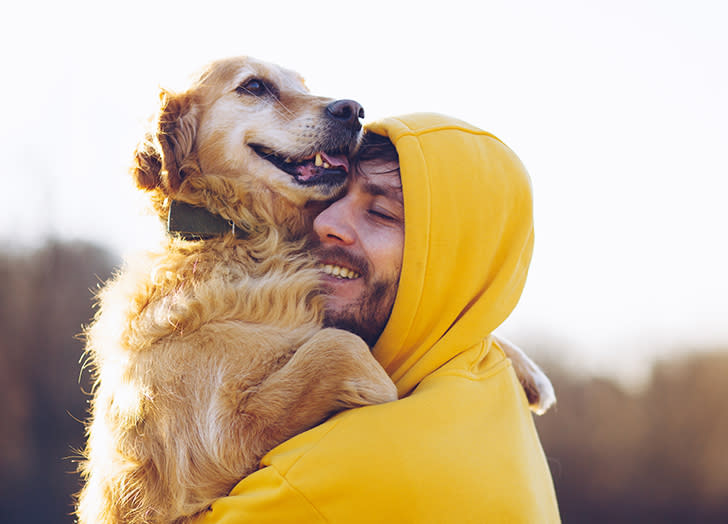4 Millennial Pet Trends That Boomers Roll Their Eyes At

- Oops!Something went wrong.Please try again later.
Maybe it was too many viewings of Air Bud, Beethoven or Homeward Bound, but kids who grew up in the ‘90s have some different ideas about pet care than their parents. That’s not to say that Gen X and baby boomers don’t care about their pets, but millennials—and now Gen Z-ers—have taken the idea of pet parenting to a whole new level. Here are four millennial pet trends that have other generations scratching their heads.
1. Negotiating Pet Perks at Work
Competitive compensation, vacation days and benefits—what else could a hard-working person ask for in a job? How about limitless Bring-Your-Dog-to-Work Days and animal-friendly policies? To a boomer, these ideas certainly sound nice but excessive—and why would you risk getting dog hair on that Brooks Brothers suit? But for a generation that saw the rise of Silicon Valley perks—kombucha on tap, ping pong tables and meditation rooms—office pet perks seem as natural as a 401K match. A 2018 survey from Wellness® Natural Pet Food found that 51 percent of millennial pet parents would consider a career change for a pet-friendly workplace, and 37 percent of pet parents would sacrifice benefits (vacation time, work from home days, etc.) if their workplace would become pet friendly.
Post-pandemic, the pet-friendly workplace trends are even more popular than ever before: A study commissioned by Banfield Pet Hospital and conducted by OnePoll, found that since millennial and Gen Z employees were the most likely to have adopted a new pet since March 2020, they were also the most likely to be planning to reach out to their employer requesting a pet-friendly policy when they return to the workplace (48 percent and 71 percent, respectively). It makes sense when you think about it. After spending so much time at home with our beloved pets, the separation anxiety goes both ways. Per SWNS Digital: “Overall, 63 percent of employees surveyed said the increased time at home has made them think more about how pets can fit into their workday, and 57 percent said they’d be happiest returning to work if they could spend the day with their pet by their side. For those respondents, the top concern for returning to work was fearing their pet would face separation anxiety if left home alone all day (38 percent).”
So, if you thought millennials put their animals first, Gen Z goes even harder for their furry friends.
2. Paying a Premium for Pet Insurance
Boomers may scoff, but that won’t change the fact that millennials put the health of their pets above, well, a lot else—a 2019 survey from HealthPocket found that 62 percent of millennials would take their pet to the vet before going to the doctor for themselves. So, it’s no wonder that pet insurance, according to Consumer Reports, is one of the fastest-growing voluntary employee benefits. And it’s becoming more popular for pet parents outside of the workplace too, with companies like Lemonade making what has been considered a not-very-consumer-friendly industry as easy as downloading an app. Though the cost-benefit of pet insurance (like any insurance) can be complicated to navigate, for millennials, the emotional cushion of knowing an unexpected, high-cost treatment of your beloved rescue cat Monster is totally worth it.
3. Including “Pet Children” in Bridal Parties
The first boomer who saw a French bulldog scamper down the aisle in a bow tie must have taken a double take. Who the hell would want to bring a pet to a wedding, no matter how casual the nuptials are? Millennials. That’s who. While boomers might have initially seen the trend as another natural extrapolation of a generational arrested development (which, psst, is a myth!), Gretchen Brown sums up the four-legged bridal party trend in a 2019 piece for Rewire: “There’s no data for how frequently pets are included in weddings. But one recent study found that 44 percent of millennials consider their pets as ‘starter children,’ almost like practice for the real thing, as they wait longer to have children of their own.” As millennials get married—and have weddings—later in life than their parents did, they’re bringing more of their adult life to the party…literally. How could you not ask your 8-year-old corgi to walk down the aisle have all you’ve been with together? Just keep Roxy away from the cake, mmmk
4. Storing Pet Food Alongside People Food in the Fridge
Though a 30-pound bag of dry food on super sale at Costco may seem fiscally enticing, fewer and fewer millennials and Gen Zers would let their pets touch such a long-winded, mystery ingredient list with a ten-foot pole. These days, 30-somethings and younger see their beloved pets not just as the family dog or cat, but as family. Period. In a February 2020 piece on pet food quality for Food Engineering, Dana Brooks, president and CEO of the Pet Food Institute (PFI) remarks: “There is 2016 research from Nielsen showing that 95 percent of pet owners considered their pets to be a part of the family, and this is a 7 percent increase from 2007.” Millennial consumers have higher expectations of what they’re feeding their pets. These standards include premium, nutrient-rich ingredients, as well as transparency in sustainability and safety practices and “cool” factors too, like branding or service (see: subscription models). Brands like Ollie, Spot and Tango, A Pup Above and the Farmer’s Dog offer some iteration of delivered-to-your-doorstep human-grade pet food, and yeah, to your mother’s horror you probably store Jasper’s meals alongside last night’s takeout (his meals are probably healthier, too).
RELATED: How to Put a Dog Bed in Your Kitchen (Without Tripping Over It Every 5 Seconds)
PureWow may receive a portion of sales from products purchased from this article, which was created independently from PureWow's editorial and sales departments.

